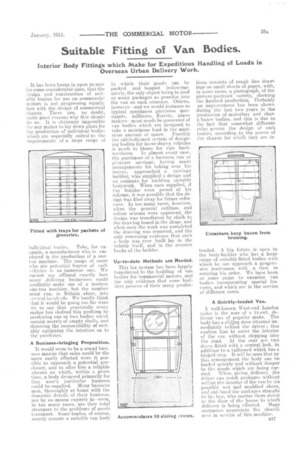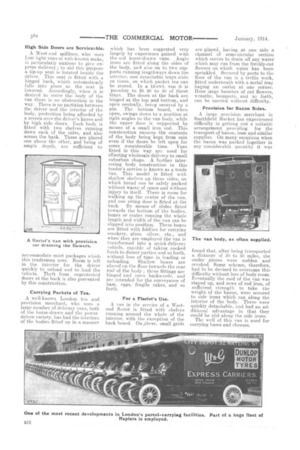Suitable Fitting of Van Bodies.
Page 39

Page 40

If you've noticed an error in this article please click here to report it so we can fix it.
Interior Body Fittings which Make for Expeditious Handling of Loads in Overseas Urban Delivery Work.
It has been borne in upon us now for some considerable time, that the design and construction of suitable bodies for use on commercial motors is not progressing equally fast with the design of commercial chassis, There are, no doubt, quite good reasons why this should be so. It is obviously impossible for any maker to lay down plant for the production of individual bodies which are especially suited to the requirements of a ia-rge range of
individual trades. Take, for ex ample, a manufacturer who is emoloyed in the production of a oneon machine. The range of users who are potential buyers of such vehicles is an immense one. We cannot say offhand exactly how many differing businesses could profitably make use of a modern one-ton machine, but the number must run, in Britain alone, into several hundreds. We hardly think that it would be going too far were we to say that practically every maker has shelved this problem by producing one or two bodies which consist merely of empty shells, and throwing the responsibility of suitably equipping the interiors on to the purchaser.
A Business-bringing Proposition.
It would seem to be a sound business maxim that sales could be the more easily effected. were it possible to approach a potential purchaser, and to offer him a reliable ehassis on which, within a given time, a body designed primarily for that user's particular business could be supplied. Many business men, thoroughly at home with the domestic details of their business, are by no means experts in—even, in too many cases, are they total strangers to the problems of goods transport. Some trades, of course, merely require a suitable van body
ia which their goods can be packed and heaped indiscriminately, the only object being to load as many packages as possible into the van on each occasion. Others, however—and we would instance as typical specimens provision merchants, milliners, florists, piano makers—must needs be possessed of van bodies which are designed to Lake a maximum load in the minimum amount of space. Possibly the old-fashioned system of designing bodies for horse-drawn vehicles is much to blame for this back wardness, In almost. every case, the purchaser of a business van or pleasure carriage, having made arrangements for taking over his horses, approached a carriage builder, who supplied a design and an estimate for building suitable bodywork. When once supplied, if the builder were proud of his scheme, it was possible that the design was filed away for future reference. In too many cases, however, when the general outlines and colour scheme were approved, the design wets transferred by chalk to the drawing board in the shops. and when once the work was completed the drawing was removed, and the only remaining evidence that such a body was ever built lay in the vehicle itself, and in the account books of the builder.
Up-to-date Methods are Needed.
This lax system has been largely transferred to the building of van bodies for 'commercial motors, and the only evidence that some builders possess of their many protium
tions consists of rough line drawings on small sheets of paper, with, in some cases, a photograph, of the picture-postcard variety, showing the finished production. Certainly an improvement has been shown during the last two years in the production ,of motorbus and charh-bancs bodies, and this is due to the fact that somewhat different rules govern the design of such bodies, according to the power of the chassis for whiCh they are in tended. A big future is open to the body-builder who has a large range of suitably-fitted bodies with which he can approach a progressive tradesman with a view to securing his order. We have been at some pains to examine van bodies incorporating special features, and which are in the service of different users.
A Quickly-loaded Van.
A well-known West-end London tailor is the user of a 15-cwt. delivery van of popular make. The body has a sliding door situated immediately behind the driver ; this enables him to enter the interior of the van without stepping into the road. At the rear are twO doors fitted with a central lock, in addition to a tailboard which has a hinged step. It will be seen that by this arrangement the body can be loaded quickly and without danger to the goods which are being car
ried. When giving delivery, the driver can redch packages without soiling the interior of the van by his possibly wet and muddied shoes, and can hand the packages straight to his boy, who carries them direct to the door of the house to which delivery is being effected. Many customers appreciate the cleanliness in service of this machine. High Side Doors are Serviceable.
A West-end milliner, who uses four light vans of welt-known make, is particularly anxious to give express delivery ; to aid this purpose a tip-up seat is located beside the driver. This seat is fitted with a hinged back, which automatically falls into place as the seat is lowered. Accordingly, when it is desired to enter the body of the van there is no obstruction in the way. There is no partition between the driver and the interior of the body, protection being afforded by a screen over the driver's knees and by high side doors. Each body is fitted with two shelves running down each of the sides, and also across the back. These are placed one above the other, and being of ample depth, are sufficient to accormnodate most packages which this tradesman uses. Room is left in the interior for the driver quickly to unload and to load the vehicle. Theft from unprotected doors at the back is also prevented by this construction.
Carrying Packets of Tea.
A well-known London tea and provision merchant, who uses a large number of delivery vans, both of the horse-drawn and the powerdriven variety, has had the interiors of the bodies fitted up in a manner
which has been suggested very largely by experience gained with the oid horse-drawn vans. Angle irons are fitted along the sides of the body, and also on to two supports running lengthways down the interior, and detachable trays siide on these, on which packet tea can be stored. In a 15-cwt. Van it is 'possible to fit 20 to 30 of these. trays. The doors at the back are hinged at the top and bottom, and open centrally, being secured by a pin. The bottom board, when open, swings down to a position at right angles to the van body,. while the upper door is supported .by means of a small iron rod. This construction ensures thle contents of the body being kept from rain even if the doors be left open for some considerable time. Vans fitted in this way are used for effecting wholesale delivery to small suburban shops. A further interesting body construction in this trader's service is known as a trade van. This model is fitted with shallow shelves on three sides, on which bread can be .safely packed without waste of space and without injury to itself. There is room for walking up the centre of the van, and one swing door is fitted at the back. By means ot slides fitted towards the bottom of the bodies, boxes or crates running the whole length and width of the van can be slipped into position. These boxes are fitted with fiddlies for carrying crockery, glass. silver, etc., and when they are employed the van is transformed into a. quick-delivery vehicle. capable of taking cooked foods to dinner parties and so forth, without losa of time in loading or unloading. Shallow boxes are placed on the floor towards the rear mad of the body ; these fittings are hinged and onen backwards, and are intended for the conveyance of ham, eggs, fragile cakes, and so forth.
For a Florist's Use.
A van in the service of a Westend florist is fitted with shelves running around the whole of the interior, with the exception of the back board. On.,these, small. grids
are placed, baying, at one side a channel of semi-circular section which serves to drain off any water avhich may run from the freshly-cut flowers on which water has been sprinkled. Secured by posts to the floor of the van is a trellis work, fitted underneath with a metal tray haying an outlet at one corner. Here large bunches of cut flowers, wreaths, bouquets, and so forth, can be carried without difficulty.
Provision for Bacon Sides.
A large provision. merchant in Smithfield Market has experienced difficulty in getting out a suitable arrangement ,providing for the transport of bacon, hain,a.hd similar supplies. On many.occasteas when the bacon was packed -together in any considerable quantity it was found that, after being transported a distance of 30 to 50 miles, the under pieces were sodden and crushed. Some scheme, therefore, had to be devised to overcome this difficulty without loss of body room. Eventually the roof of the van was stayed up, and rows of rod iron, of sufficient strength to take the weight of the bacon, were secured to side irons which ran. along the interior of the body. These were quickly detachable, and had an additional advantage in that they could be slid along the side irons.
The well of this van is used for e.arrying hams and cheeses.






















































































